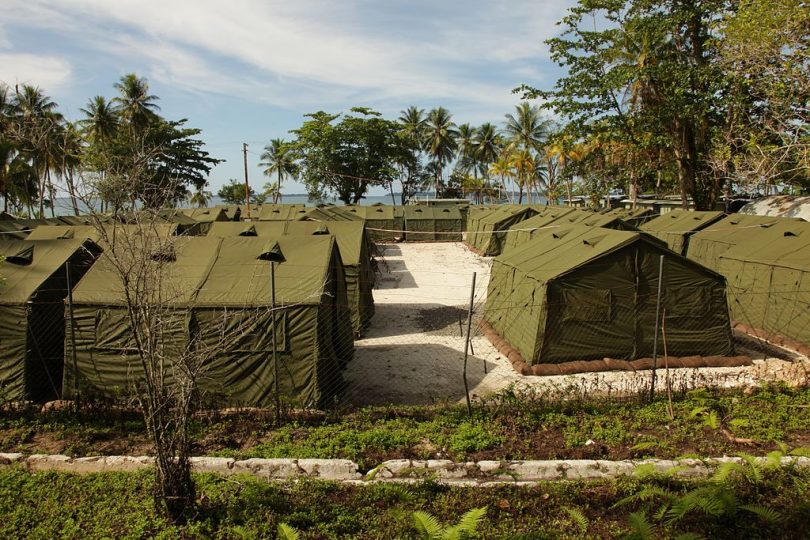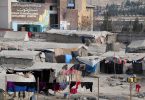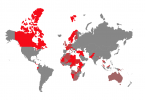Since 2014, seven asylum seekers and refugees have died in immigration detention centres on Manus Island and Nauru, according to the Australian Border Deaths database. One man was found dead in Manus Island on Monday and conditions for asylum seekers are becoming increasingly dangerous as parts of the Manus Island detention centre are shut down.
Amnesty International Australia refugee co-ordinator Graham Thorn told The Sydney Morning Herald irrespective of the cause of death, “Australia must accept liability for the damage its cruel policies are causing refugees”.
Below are the stories of seven asylum seekers who died in Australia’s care on Manus Island and Nauru since 2014.
Hamed Shamshiripour

Hamed Shamshiripour died under Australia’s care on Manus Island on Monday. Picture: Supplied.
Hamed Shamshiripour was the fifth man to die under Australia’s supervision on Manus Island.
The 31-year-old Iranian national was found dead near the Refugee Transit Centre in East Lorengau on Monday.
Hamed, who had been living at the Manus Island detention centre as an asylum seeker, had a reported history of mental illness. Local police suggested he may have taken his own life.
The Guardian reported Hamed’s friends had previously begged with Australian authorities for him to be treated. Several refugees said he had made previous attempts to commit suicide. He had spent some time in Australia for medical treatment.
Hamed was originally rejected for refugee status, but it was currently being reviewed.
In June last year The Guardian reported Hamed was found naked and yelling in a distressed state in his compound. He was arrested, taken to Lorengau prison, then transferred to the “managed accommodation area” for people with mental health problems in the detention centre. Fourteen refugees and asylum seekers made a formal complaint guards were beating Hamed instead of caring for him.
“We, the signatories to this complaint form want to know why you are not providing mental health support to Hamed … and instead you have subjected him to ill-treatment and corporal punishment because he is not behaving normally due to his mental ailment.”
Hamed was jailed several times after mental breakdowns and behaving unpredictably or aggressively.
Manus Island MP Ron Knight said Hamed was not receiving mental healthcare.
“To be blunt, the guy is dangerous to all around him and he needs psychiatric help. There is none for him here,” he told The Guardian.
Ron Knight on Twitter: “A refugee has hung himself behind loreast centre. Is this what dutton wants? Shame / Twitter”
A refugee has hung himself behind loreast centre. Is this what dutton wants? Shame
Local police said suicide was the suspected cause of death, but many refugees on Manus Island were suspicious violence in the community caused Hamed’s death. Many refugees and asylum seekers are concerned for their safety in East Lorengau as they are moved to the refugee transit centre.
Faysal Ishak Ahmed

Concerns have been raised following Faysal Ishak Ahmed’s death that he was denied access to medical treatment. Picture: Supplied.
Manus Island detainee Faysal Ishak Ahmed died after collapsing, hitting his head and suffering a seizure in December 2016.
Concerns were raised after the 27-year-old Sudanese refugee was denied access to medical treatment.
Faysal had been complaining of chest pains, swollen arms and fingers, breathing problems and high blood pressure in the six months before his death.
He submitted a complaint form to the medical clinic wanting to know why more than 20 visits to the medical centre had not produced a diagnosis or a treatment plan.
Sixty Sudanese detainees wrote to the International Health and Medical Services about Faysal’s complaints his health was not being taken seriously by the medical centre.
Faysal was flown to Brisbane after suffering a seizure at the island’s detention centre and died two days later.
Kamil Hussain

Pakistani refugee Kamil Hussain drowned in a waterfall on Manus Island. Picture: Supplied.
Kamil Hussain drowned at a waterfall on Manus Island near Lorengau on August 2 2016.
Kamil was a Pakistani refugee held at an Australian-run centre.
Refugees and asylum seekers held a small protest in the detention centre after disputes as to whether Papua New Guinea or Australia was responsible for returning his body to Pakistan.
The men detained on the island had been allowed to leave the detention centre and move freely since April when Papua New Guinea’s Supreme Court ruled the detention of asylum seekers was illegal.
Unnamed man

The hospital on Nauru. A Bangladeshi man died of a suspected heart attack after admitting himself to hospital for chest pains. Picture: The Guardian.
A 26-year-old Bangladeshi refugee died in a Nauru hospital from suspected heart failure in May 2016.
He admitted himself to a Nauru hospital experiencing chest pains and died two days later after a series of heart attacks. The Department of Immigration and Border protection said in a statement an air ambulance had been dispatched but the man was not able to be transferred because of his condition. The speed of the hospital’s response has been questioned.
Refugees also said an overdose on medicines may have contributed to his death, reporting he consumed a large amoung of pills including Panadol before going to hospital.
Omid Masoumali

Omid Masoumali set himself on fire after Canberra-based UNHCR officials reportedly told him he would spend the next 10 years on Nauru. Picture: Supplied.
Omid Masoumali died after setting himself on fire at the Australian-run Nauru detention centre in April 2016.
The 23-year-old Iranian refugee set himself on fire in front of three Canberra-based UNHCR. He died in a Brisbane hospital two days after.
His wife said Omid was without doctors care for two hours at the medical facility and it was eight hours before morphine was administered. Concerns were raised about the medical care he received at Nauru hospital where he spent 24-hours before being airlifted to Brisbane.
Fellow asylum seekers and refugees said Omid self-immolated after UNHCR staff told the group they would be on Nauru for another 10 years.
Omid had been on Nauru for three years. He had requested to be sent to a third country.
Omid fled life in Iran with his wife feeling unsafe in their home country. Both were formally granted refugee status. They arrived in Australia by boat in September 2013 and were sent to Nauru after nine days on Christmas island.
Omid’s wife has since been held in isolated detention in Australia.
Australia’s Immigration Minister Peter Dutton sent condolences after his death but also said refugees sent offshore would “never settle in Australia”.
Peter Dutton on Twitter: “This achievement demonstrates beyond doubt that the Coalition’s tough border protection policies have & are working. pic.twitter.com/EwXorwdAiG / Twitter”
This achievement demonstrates beyond doubt that the Coalition’s tough border protection policies have & are working. pic.twitter.com/EwXorwdAiG
Hamid Khazaei

Hamid Khazaei died in a Brisbane hospital in August 2014 after a cut on his leg became severely infected. Picture: Supplied.
Hamid Kazhaei died after a cut on his foot became infected while in detention on Manus Island.
The 24-year-old Pakistani died in a Brisbane hospital in August 2014.
Hamid suffered severe sepsis from his leg infection and was flown from Manus Island to Port Moresby three days after presenting to the detention centre medical clinic with a fever and chills.
Requests to move him to hospital were delayed and resisted. Findings from an inquest raised concerns about the standard of medical treatment for asylum seekers and refugees in Australia’s care.
The inquest found doctors staff ignored instructions to provide Hamid with intravenous paracetamol two nights in a row, resulting in increasing pain, vomiting, confusion and a lack of oxygen to his brain. It also found he was left unsheltered from the tropical sun at the airfield during his transfer.
As he became increasingly sick and confused Hamid screamed, was unable to recognise family and friends and pulled intravenous lines from his arm. It was found his health deteriorated rapidly while being treated in detention and Australian immigration department officials ignored or refused requests to have him moved to a hospital.
The Guardian reported: “Australia controls offshore detention, and micromanages the decisions that take place within the camps on Nauru and Manus Island. No asylum seeker or refugee can be moved from an offshore camp without the express permission of the Department of Immigration and Border Protection in Canberra.”
Reza Barati

Candlelit vigils folllowed the death of Reza Barati, calling for justice. Picture: Richard Milnes/Demotix/Corbis/The Guardian
Reza Barati was beaten to death during rioting at the Manus Island detention centre on February 18 2014.
Detention centre staff beat the 23-year-old Iranian with a stick and dropped a rock on his head during riots. Two Papua New Guinean detention centre workers were convicted with his murder.
One witness statement provided to police said: “Reza Barati was bleeding very heavily from the injury on his head. I saw Reza Barati was still alive at that time when he was lying on the wire floor. The G4S guards who were chasing him from behind reached him and kicked him [Barati] on his head with their boots. I saw about a total of 13 G4S local officers and two expatriate officers kicked Reza Barati in his head with their boots. He was putting up his hands trying to block the blows from the boots.
“I then saw this man who was a G4S guard (local) with one eye. He held on to a stone, which was about 30cm wide and 50cm in height. Saw him lifted the stone up with both hands above his head and threw it very hard on Reza Barati’s head while he was still lying on the wire floor. I think at that time when he threw the stone Reza died.”
A parliamentary inquiry found violence in the Manus Island detention centre was “eminently foreseeable” and the Australian government were responsible for his death.
The report said the detention centre was not secure from outside invasion, despite knowledge of local hostility for more than 18 months. It also stated the centre was overcrowded at almost double intended capacity.
It was found the failure to process refugee claims and the lack of explanation to asylum seekers about what was going to happen to them caused the violence.
More than 70 refugees and asylum seekers were seriously injured during the riots.
Call Lifeline on 13 11 14 for support.







